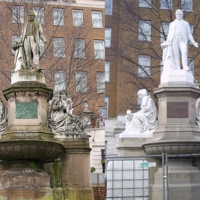
Rededication of memorial to Joseph Sturge
A nineteenth-century monument celebrating the philanthropic efforts and commitment to social reform of the Quaker abolitionist Joseph Sturge was restored from a state of disrepair in 2007 as part of Birmingham's bicentenary commemorations. The monument, sculpted by John Thomas, was first unveiled in 1862 by the city's nonconformist religious leaders and local businessmen to celebrate Sturge's legacy. The restoration work was carried out with funding from Birmingham City Council, The Birmingham Civic Society and the Sturge Family. A rededication service took place on 24 March 2007.
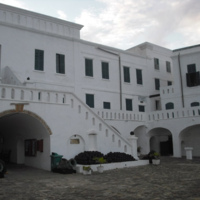
Cape Coast Castle
Cape Coast Castle is one of around forty ‘slave castles’ built by European traders on the coast of West Africa and used to hold enslaved Africans prior to their being transported to the Americas or the Caribbean. The first timber construction on the site was erected in 1653 for the Swedish Africa Company named Carolusborg. It was later rebuilt in stone. In April 1663 the ‘Swedish Gold Coast’ was seized by the Danes and integrated into the ‘Danish Gold Coast’. In 1664 it was conquered by the British. Originally used for trade in timber and gold, the castle was later used in the transatlantic slave trade. In the late 18th century it was rebuilt and used as the seat of the colonial Government of the British Gold Coast in 1844. In 1957, when Ghana became independent, the site came under the care of the Ghana Museums and Monuments Board, and was restored for public access in the 1990s. The museum offers guided tours, as well as permitting tours orchestrated by freelance tour guides. There is also a library and a gift shop, featuring traditional Ghanaian arts and crafts, on site.
The main aim of the museum is to act as a monument to those taken from Africa and enslaved into the system of Transatlantic Slavery. It features both archaeological and ethnographic collections on displays, within the rooms of the castle. Throughout, there are also a number of contemporary sculptures depicting the heads of victims of the slave trade. Visitors tour through the castle, encountering the rooms in which the enslaved were held, with guides providing further information about the conditions and experiences those thousands of Africans faced.
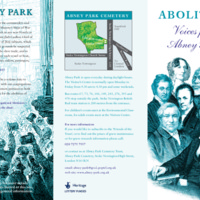
Abolition Voices from Abney Park
Abney Park is a non-denominational cemetery in Stoke Newington, London. The walking tour Abolition Voices from Abney Park was developed to highlight the individuals connected with the abolition of slavery buried there, including the Baptist missionary Reverend Thomas Burchill (associated with Samuel Sharpe and the 'Baptist War' in Jamaica), Reverend Newman Hall and Reverend James Sherman (both associated with abolition in the USA). The grave of Joanna Vassa, daughter of Olaudah Equiano, was identified and restored. The monument to Joanna Vassa was designated Grade II listing by Historic England in 2008 as part of the bicentenary commemorations. There were accompanying talks and school workshops. Abney Park Cemetery Trust was also responsible for the carving of a new memorial stone for the writer Eric Walrond.
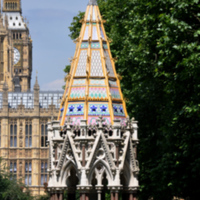
Restoration of the Buxton Memorial Fountain
The Buxton Memorial Fountain was built by Charles Buxton to celebrate the Slavery Abolition Act of 1833 and the achievement of his father, the abolitionist Thomas Fowell Buxton, and his associates who led the parliamentary campaign to abolish slavery. The memorial fountain was built in Parliament Square in 1865-6, and re-erected in Victoria Tower Gardens, Westminster, in 1957. Following extensive restoration by The Royal Parks, the memorial was unveiled on 27 March 2007, to mark the bicentenary. The listed monument was also upgraded from Grade II to II* in 2007.
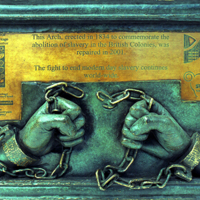
Anti-Slavery Arch, Stroud
The Anti-Slavery Arch in Stroud is Britain's oldest anti-slavery memorial. It was built by Henry Wyatt in 1834 to celebrate the passing of the Abolition of Slavery Act of 1833. A local businessman and supporter of the Stroud Anti-Slavery Society, Wyatt built the arch as an entrance to the carriage drive of his private estate. Established in 2000, the 'Anti-Slavery Arch Group' raised funds to address the preservation needs of the arch. This community project carried out major stone repairs, added a bronze plaque, produced a leaflet and website, and wrote and performed a play with students from Archway School (built on the site of Wyatt's mansion in the 1960s). In 2007, the monument was upgraded from a Grade II listing to Grade II*.
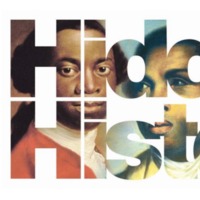
Hertfordshire's Hidden Histories
This partnership project, led by Hertfordshire Archives, investigated the links between Hertfordshire people, the slave trade and abolition through stories from original archival documents. Project outcomes included creative workshops, a booklist, a DVD documentary, a heritage trail booklet, and collaboration with the project for the restoration of the Thomas Clarkson monument in Thundridge. The monument was erected in 1879 to mark his involvement in the campaign to abolish slavery. The ceremony to re-dedicate the monument in November 2007 involved pupils from Thundridge Primary School performing a dance that they had developed with arts-led charity Theatre Is….